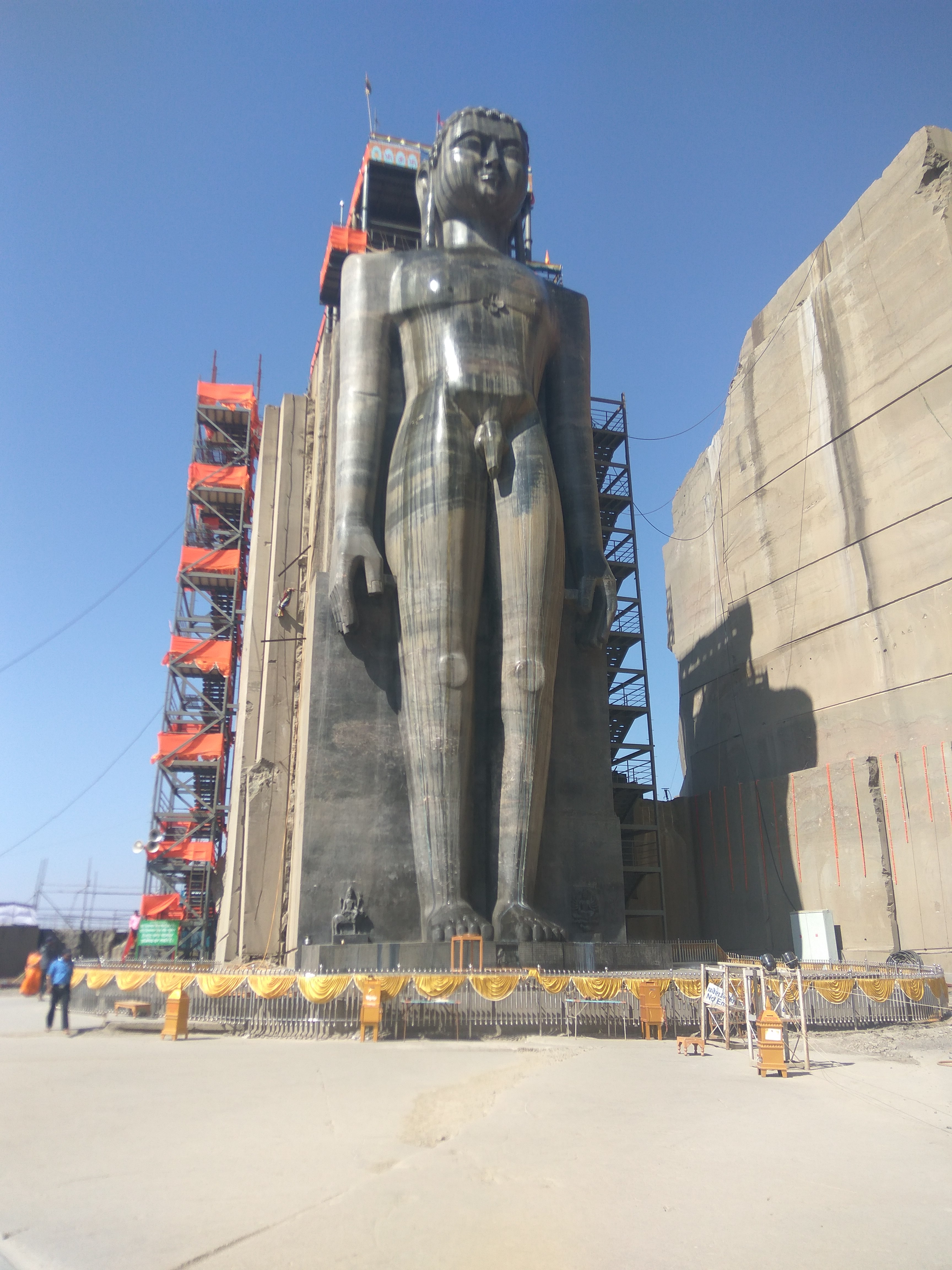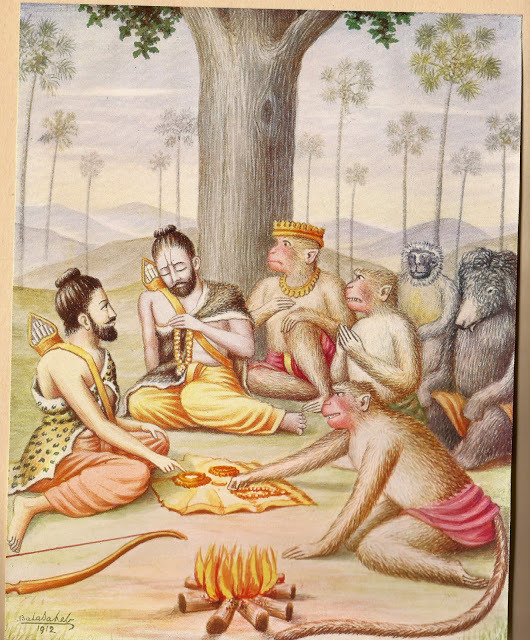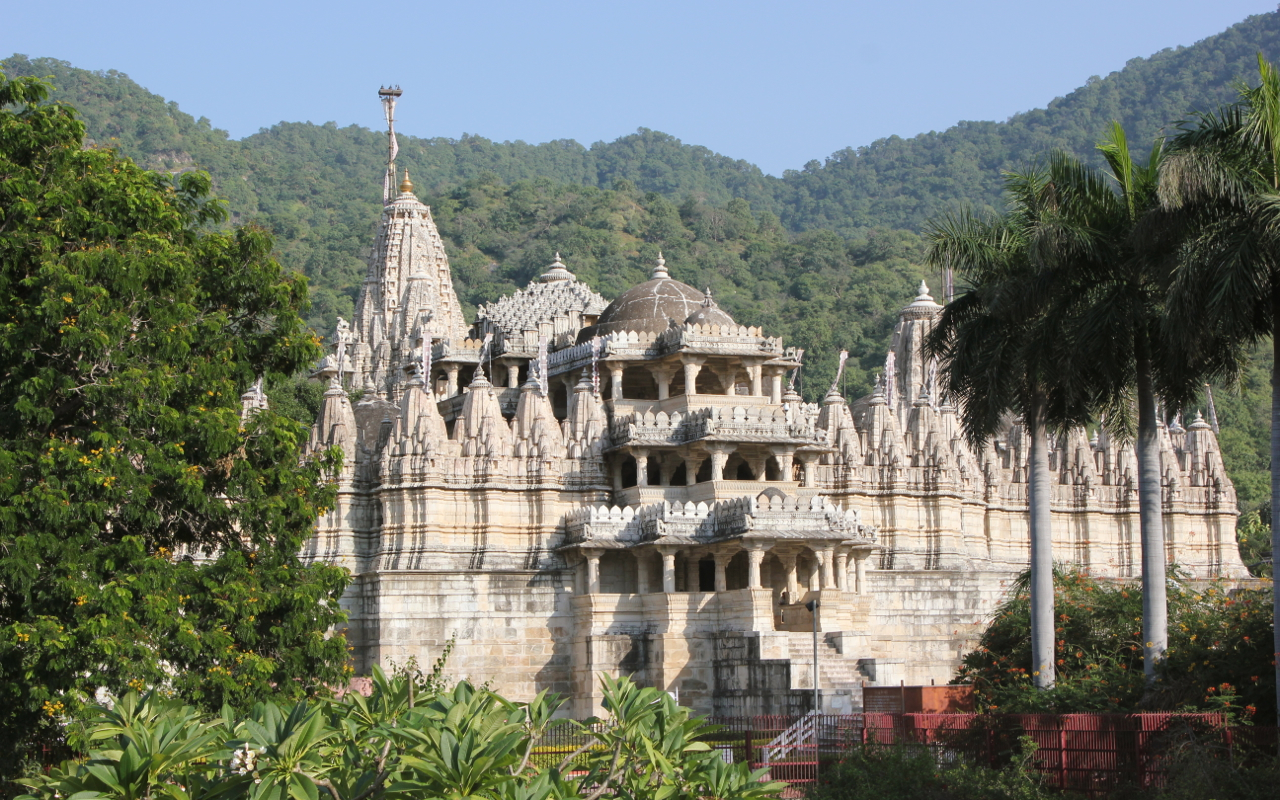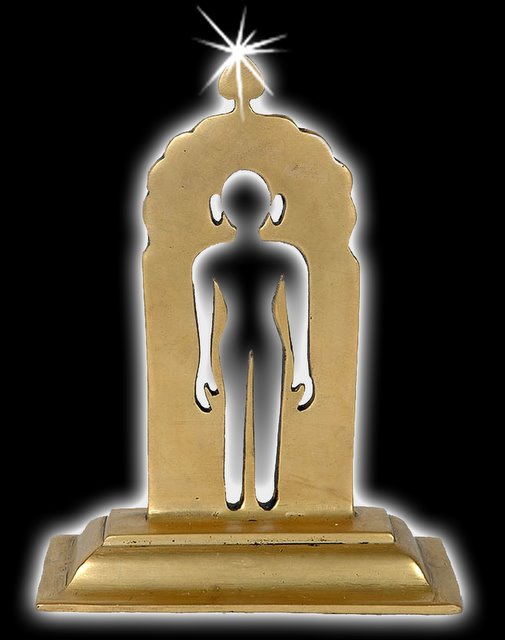|
Mangi-Tungi
Mangi-Tungi is a prominent twin-pinnacled peak and Digambar Jain Pilgrimage Site, located near Tahrabad about 125 km from Nashik, Maharashtra, India. Mangi, high above sea level, is the western pinnacle and Tungi, high, the eastern. Mangi-Tungi is from the city of Satana. Overview There are numerous temples and is considered sacred in Jainism. It enshrines images of Tirthankaras in several postures including '' Padmasana'' and ''kayotsarga''. Sometimes, it is described as ''Siddha Kshetra'', meaning a gateway to the state of enlightenment. Around 3,500 (7,000 Up & Down) steps lead to the foot of the peak, which is enriched with several monuments of historical and religious prominence. Besides, there are numerous caves named after great Tirthankaras such as Mahavira, Rishabhanatha, Shantinatha and Parshvanatha. A grand fair is held here annually during ''Kartik'' (September–October) where people visit in large numbers to witness festival. There are many inscript ... [...More Info...] [...Related Items...] OR: [Wikipedia] [Google] [Baidu] [Amazon] |
Jainism
Jainism ( ), also known as Jain Dharma, is an Indian religions, Indian religion whose three main pillars are nonviolence (), asceticism (), and a rejection of all simplistic and one-sided views of truth and reality (). Jainism traces its spiritual ideas and history through the succession of twenty-four , supreme preachers of ''dharma''. The first in the current time cycle is Rishabhadeva, who tradition holds lived millions of years ago; the 23rd is Parshvanatha, traditionally dated to the 9th century Common Era, BCE; and the 24th is Mahāvīra, Mahavira, who lived . Jainism is considered an eternal ''dharma'' with the guiding every time cycle of the Jain cosmology, cosmology. Central to understanding Jain philosophy is the concept of ''bhedavijñāna'', or the clear distinction in the nature of the soul and non-soul entities. This principle underscores the innate purity and potential for liberation within every Jīva (Jainism), soul, distinct from the physical and menta ... [...More Info...] [...Related Items...] OR: [Wikipedia] [Google] [Baidu] [Amazon] |
Rishabhanatha
Rishabhanatha (Devanagari: ऋषभनाथ), also Rishabhadeva (Devanagari: ऋषभदेव, ), Rishabha (Devanagari: ऋषभ, ) or Ikshvaku (Devanagari: इक्ष्वाकु, ''Ikṣvāku''), is the first (Supreme preacher) of Jainism. He was the first of twenty-four teachers in the present half-cycle of time in Jain cosmology and called a "ford maker" because his teachings helped one cross the sea of interminable rebirths and deaths. The legends depict him as having lived millions of years ago. He was the spiritual successor of Sampratti Bhagwan, the last Tirthankara of the previous time cycle. He is also known as Ādinātha (), as well as Adishvara (first Jina), Yugadideva (first deva of the yuga), Prathamarajeshwara (first God-king) and Nabheya (son of Nabhi). He is also known as Ikshvaku, establisher of the Ikshvaku dynasty. Along with Mahavira, Parshvanath, Neminath, and Shantinath, Rishabhanatha is one of the five Tirthankaras that attract the most d ... [...More Info...] [...Related Items...] OR: [Wikipedia] [Google] [Baidu] [Amazon] |
Nashik
Nashik, formerly Nasik, is a city in the northern region of the Indian state of Maharashtra situated on the banks of the river Godavari, about northeast of the state capital Mumbai. Nashik is one of the Hindu pilgrimage sites of the Kumbh Mela, which is held every 12 years. According to the ''Ramayana'', Nashik is the location on the banks of the Godavari River where Lakshmana cut the nose of the demoness Shurpanakha. It is also called Panchavati. It was known as "Gulshanabad" during the Mughal period. History Mythology Nashik was known as "Padmanagar" during the Satya Yuga, "Trikantak" during the Treta Yuga, "Janasthana" during the Dvapara Yuga, and finally "Navashikh" or "Nashik" during the Kali Yuga, according to Hindu traditions. Nashik is significant in history, social life, and culture. The city is located on the banks of the Godavari River, making it a sacred site for Hindus around the world. During his 14-year exile from Ayodhya, Rama, the king of Ayod ... [...More Info...] [...Related Items...] OR: [Wikipedia] [Google] [Baidu] [Amazon] |
Nashik District
Nashik district,(Marathi: Help:IPA/Marathi, [n̪ɑɕɪk]) formerly known as Nasik district, is a district in Maharashtra, India. The city of Nashik is the administrative headquarters of the district. Nashik is well known for the production of wine. Nashik is also known as Mini Maharashtra, because the climate and soil conditions of Surgana, Peth, Igatpuri resembles with Konkan. Niphad, Sinnar, Dindori, Baglan blocks are like Western Maharashtra and Yeola, Nandgaon, Maharashtra, Nandgaon, Chandwad blocks are like Vidarbha Region. Nashik is the biggest city in the district while Malegaon is the second biggest city. Manmad, Igatpuri, and Sinnar are some of the big cities situated in the Nashik District. Manmad is one of the biggest railway junctions in India while the city of Malegaon is famous for its powerloom. Nashik district is the third largest district in Maharashtra state in terms of population of 8,107,187 and occupying an area of 15,582 square kilometres in the north Maharas ... [...More Info...] [...Related Items...] OR: [Wikipedia] [Google] [Baidu] [Amazon] |
Sugriva
Sugriva (, ), is a character In the ancient Hindu epic Ramayana. He is the younger brother of Vali (Ramayana), Vali, whom he succeeded as ruler of the vanara kingdom of Kishkindha. He is a son of Surya, the Hindu deity of the sun. As the king of the vanaras, Sugriva aided Rama in his quest to liberate his wife Sita from captivity at the hands of the rakshasa king Ravana. Nomenclature He is also known as , , , , , Creole language, Creole: Soogrim, , , , Sugreeva or Sugreev. Malayalam:Sugreevan. Legend The story of Sugriva is part of Ramayana and in an abbreviated version, is also present in the Mahabharata. The king of Kishkindha, Vrikshraja, was a divine creature born from Brahma's tilaka. He had the body of a human and face and tail of a monkey. He was instructed to roam the forests and kill demons. One day, Vriksharaja entered an enchanted pond, and was transformed into a beautiful lady, attracting the attention of both Indra and Surya. Soon after, they each sired Vali ... [...More Info...] [...Related Items...] OR: [Wikipedia] [Google] [Baidu] [Amazon] |
Tirtha (Jainism)
In Jainism, a ''tīrtha'' ( " ford, a shallow part of a body of water that may be easily crossed") is used to refer both to pilgrimage sites as well as to the four sections of the ''sangha''. A ''tirtha'' provides the inspiration to enable one to cross over from worldly engagement to the side of ''moksha''. Jain ''tirthas'' are located throughout India. Often a ''tirtha'' has a number of temples as well as residences (dharmashala) for the pilgrims and wandering monks and scholars. Types ''Tirtha'' sites include: * ''Siddhakshetra''s or site of ''moksha'' liberation of an '' arihant'' (''kevalin'') or Tirthankaras like Ashtapada Hill, Shikharji, Girnar, Pawapuri, Palitana, Mangi-Tungi and Champapuri (capital of Anga) * ''Atishayakshetra''s where divine events have occurred like Mahavirji, Rishabhdeo, Kundalpur, Aharji etc. * ''Puranakshetra''s associated with lives of great men like Ayodhya, Vidisha, Hastinapur, and Rajgir * ''Gyanakshetra'': associated with famous '' ... [...More Info...] [...Related Items...] OR: [Wikipedia] [Google] [Baidu] [Amazon] |
Nila (Ramayana)
Nila (), also spelled as Neela, is a character in the Hinduism, Hindu epic Ramayana. He is a vanara chieftain in the army of Rama, the prince of Ayodhya (Ramayana), Ayodhya and avatar of the god Vishnu. He is the commander-in-chief of the vanara army under the vanara king Sugriva, and is described as leading the army in Rama's battle against the rakshasa king Ravana of Lanka (identified with modern-day Sri Lanka) and as killing many rakshasas. Legend In the Ramayana, Nila is described as the son of Agni, the god of fire, and as the "Kapishreshtha (foremost among the vanaras) in effulgence, reputation, and prowess". An important part of the epic describes the role played by the vanara army in the rescue of Sita, the wife of Rama who is kidnapped by Ravana, the rakshasa king of Lanka. The many stories forming the epic are retold in various adaptations. Search for Sita The ''Ramayana'' describes Nila as the commander-in-chief of the vanara army, under the king Sugriva. Sugriva ord ... [...More Info...] [...Related Items...] OR: [Wikipedia] [Google] [Baidu] [Amazon] |
Yakshini
Yakshinis or Yakshis (, , Prakrit languages, Prakrit: ) are a class of female nature spirits in Hinduism, Hindu, Buddhism, Buddhist, and Jainism, Jain religious mythologies that are different from Hindu deities, Devas and Asuras and Gandharvas or Apsaras. Yakshinis and their male counterparts, the Yakshas, are one of the many paranormal beings associated with the centuries-old sacred groves of India. Yakshis are also found in the traditional legends of Northeast India, Northeastern Indian tribes, ancient legends of Kerala, and in the folktales of Kashmiri Muslims. Sikhism also mentions yakshas in its sacred texts. The well behaved and benign ones are worshipped as tutelary deities, tutelaries, they are the attendees of Kubera, the treasurer of the gods, and also the Hindu god of wealth who ruled Himalayas, Himalayan kingdom of Alaka. There are also malign and mischievous yakshinis with poltergeist-like behaviours, that can haunt and curse humans according to Folklore of India, ... [...More Info...] [...Related Items...] OR: [Wikipedia] [Google] [Baidu] [Amazon] |
Yaksha
The Yakshas (, , ) in Mythology are a broad class of nature spirits, usually benevolent, but sometimes mischievous or capricious, connected with water, fertility, trees, the forest, treasure and wilderness. They appear in Hindu, Jain and Buddhist texts, as well as ancient and medieval era temples of South Asia and Southeast Asia as guardian deities. The feminine form of the word is or Yakshini (, ; ). In Hindu, Jain and Buddhist texts, the s have a dual personality. On the one hand, a may be an inoffensive nature-fairy, associated with woods and mountains; but there is also a darker version of the , which is a kind of ( bhuta) that haunts the wilderness and waylays and devours travellers, similar to the rakṣasas. Early yakshas Yakshas appear in Hindu, Jain and Buddhist texts. Several monumental yakshas are known from the time of the Maurya Empire period. They are variously dated from around the 3rd century BCE to the 1st century BCE. These statues are monumental (usua ... [...More Info...] [...Related Items...] OR: [Wikipedia] [Google] [Baidu] [Amazon] |
The Hindu
''The Hindu'' is an Indian English-language daily newspaper owned by The Hindu Group, headquartered in Chennai, Tamil Nadu. It was founded as a weekly publication in 1878 by the Triplicane Six, becoming a daily in 1889. It is one of the Indian Newspaper of record, newspapers of record. , ''The Hindu'' is published from 21 locations across 11 states of India. ''The Hindu'' has been a family-owned newspaper since 1905, when it was purchased by S. Kasturi Ranga Iyengar from the original founders. It is now jointly owned by Iyengar's descendants, referred to as the "Kasturi family", who serve as the directors of the holding company. Except for a period of around two years, when Siddharth Varadarajan, S. Varadarajan held the editorship of the newspaper, senior editorial positions of the paper have always been held by members of the original Iyengar family or by those appointed by them under their direction. In June 2023, the former chairperson of the group, Malini Parthasarathy, w ... [...More Info...] [...Related Items...] OR: [Wikipedia] [Google] [Baidu] [Amazon] |
Indra
Indra (; ) is the Hindu god of weather, considered the king of the Deva (Hinduism), Devas and Svarga in Hinduism. He is associated with the sky, lightning, weather, thunder, storms, rains, river flows, and war. [3 volumes] Indra is the most frequently mentioned deity in the ''Rigveda''. He is celebrated for his powers based on his status as a god of order, and as the one who killed the great evil, an Asura (Hinduism), asura named Vritra, who obstructed human prosperity and happiness. Indra destroys Vritra and his "deceiving forces", and thereby brings rain and sunshine as the saviour of mankind. Indra's significance diminishes in the post-Vedic Indian literature, but he still plays an important role in various mythological events. He is depicted as a powerful hero. According to the ''Vishnu Purana'', Indra is the title borne by the king of the gods, which changes every Manvantara – a cyclic period of time in Hindu cosmology. Each Manvantara has its own Indra and the In ... [...More Info...] [...Related Items...] OR: [Wikipedia] [Google] [Baidu] [Amazon] |
Siddha
''Siddha'' (Sanskrit: '; "perfected one") is a term that is used widely in Indian religions and culture. It means "one who is accomplished." It refers to perfected masters who have achieved a high degree of perfection of the intellect as well as moksha, liberation or Enlightenment in Buddhism, enlightenment. In Jainism, the term is used to refer to the liberated souls. ''Siddha'' may also refer to one who has attained a siddhi, paranormal capabilities. Siddhas may broadly refer to siddhars, naths, asceticism, ascetics, sadhus, or yogis because they all practice sādhanā. Jainism In Jainism, the term ''siddha'' is used to refer the liberated souls who have destroyed all Karma in Jainism, karmas and have obtained Moksha (Jainism), moksha.They are free from the transmigratory cycle of birth and death (''Saṃsāra (Jainism), saṃsāra'') and are above ''Arihant (Jainism), Arihantas'' (omniscient beings). Siddhas do not have a body; they are soul in its purest form. They r ... [...More Info...] [...Related Items...] OR: [Wikipedia] [Google] [Baidu] [Amazon] |









